
TEXT
BioMass B500, B1000
OPERATION AND MAINTENANCE MANUAL
By SteelTech Inc.
Version 3
UL 2523-2009
CAN/CSA B366.1-2011
TEXT

2

heatmasterss.com 3
TEXT
Contents
Warranty and Safety
Warranty Registration & Delivery Form .........Front Insert
Warranty Details ..................................4
Water Treatment And Testing ........................5
Safety Precautions.................................6
Furnace Installation Guide
Specifications ....................................7
Location ........................................7
Clearances To Combustibles.........................7
Furnace Foundation .............................8-9
Trench .........................................10
Indoor Installation............................. 10-12
Wiring And Hydronic Lines ...................... 12-15
Wiring Diagram
B500, B1000 Wiring Diagram .......................16
Field Wiring Diagram .............................17
Wood Quality
Storing wood chips ...............................18
Controls And Safety Devices ....................19-22
How the B-Series Biomass Furnace Works .........22-23
Operating The Furnace
Filling The Furnace With Water ......................24
Firing The Furnace............................. 24-25
Furnace Components..........................26-27
Care And Maintenance .......................... 28
Troubleshooting
Troubleshooting Poor Combustion
And Low Heat Output .......................... 29-32
Electrical Troubleshooting ..........................32
RETAIN THIS MANUAL FOR
FUTURE REFERENCE
DO NOT THROW AWAY
CANADA
SteelTech Inc.
Box 158
Winkler MB. R6W 4A5
Canada
Ph. (204) 325-9792
Fax (204) 325-9803
USA
SteelTech Inc.
Box 373
Walhalla ND. 58282
Ph. (877) 325-9792
Fax (204) 325-325-9803
www.heatmasterss.com

4
LIMITED WARRANTY
SteelTech Inc. warrants to the original owner of the Biomass
furnace that it is free from defects in workmanship and
material, which could cause a leak or malfunction of
the firebox or water jacket, and against corrosion (if the
instructions in the owners manual for water treatment
and maintenance are followed) for the life of the furnace
towards the purchase of a new HeatMaster
SS
furnace, in the
following pro-rated schedule.
Warranty schedule: coverage in the initial
5 years is 100%
• Year 6 - 7 is 50%
• Year 8 - 9 is 40%
• Year 10 - 15 is 30%
• Year 16 to life is 10%
In addition, all steel and drive components including
housing, legs, Augers, Burners, etc. have a pro-rated
warranty for a period of 10 years with coverage reducing by
10% per year. Any parts not manufactured by SteelTech Inc.,
that are used on the furnace – such as thermostats, limit
switches, pumps, heat exchangers, burners, augers, and
motors – carry their own manufacturer’s warranty. SteelTech
Inc. will not be liable for the cost of shipping, replacement
or repair of these parts.
If warranty requires removal or replacement of the furnace
or a part on the furnace, Steel-Tech Inc. is not responsible
for the cost of plumbing, replacement of antifreeze or water
treatment, shipping cost or any other cost other than the
replacement component or furnace.
SteelTech Inc. always has the right to decide if a part
or furnace will be repaired or replaced and will not be
liable for any cost not authorized by a SteelTech Inc.
representative.
SteelTech Inc. does not warranty any damage caused by
negligence and deterioration due to lack of proper ongoing
maintenance, physical damage caused by abuse or freeze
up power surges or unauthorized work, or modifications to
the furnace.
SteelTech Inc. is not liable for any damage or cost which
may occur from or during the operation of the furnace
or damage incurred due to any heating system failure.
The purchaser assumes all responsibility for the care,
maintenance and safe operation of the furnace including
adding of approved furnace treatment or water. SteelTech
Inc does not warrant door gaskets, exterior paint or finish.
To qualify for warranty all instructions must be followed in
operator’s manual, water must be tested and maintained
at a minimum of once per year, and warranty registration
must be on file at SteelTech Inc. within 30 days of purchase
along with a copy of the original invoice. No warranty can
be approved unless the warranty registration and water test
verifications are on file at SteelTech Inc.’s office.
The warranty can be violated by operating the furnace in a
manner inconsistent with the owner’s manual.
SteelTech Inc. reserves the right to change conditions of
warranty at any time.

heatmasterss.com 5
TEXT
WATER TREATMENT AND TESTING
Water Treatment Policy
To qualify for warranty, water must be tested at a minimum
of once per year and water treatment added when
necessary.
To take a water sample:
• Locate your water sample bottle, mailing carton and
mailing label provided to you by your dealer.
• Open the furnace drain located in the side pump
cabinet of the furnace for 10-15 seconds or until the
water runs clear. CAUTION: Water is hot! Use extreme
care when pouring into a bucket, and let cool before
collecting a sample.
• Fill one of the test bottles at least 1/2 to 2/3 full.
• Fill out the mailing label provided with the test bottle
completely, including your email address, the model
number and the serial number of your furnace. Make
sure to note if the furnace water contains any antifreeze
or additional chemicals.
• Attach top part of the label to sample bottle and
bottom part to the outside of mailing tube. Place
bottle in the tube.
• Mail to our testing lab. Results can take up to 4 weeks
to receive and up to 8 weeks if no email address is on
hand at HeatMaster
SS
.
• You will receive a water test report outlining what must
be done (if anything). If any action is necessary, take
another sample and mail it to our test lab again to
verify the recommended changes have been made.
Add the water treatment through the fill pipe located at the
top of the furnace when initially filling the furnace with water
or after testing, if needed. Ensure that all drains are closed.
It is recommended that water treatment is added at a 1:200
ratio when initially firing the furnace and 1:300 after that.
Additional treatment may have to be added for water with
more severe properties or for systems with more chemically
demanding requirements.
Recommended operating levels are as
follows:
Conductivity: 100 - 4000 ppm
pH: 8.5 – 10. 5
Nitrates: no less than 730 ppm
Test Parameters and What They Mean
Conductivity
Conductivity is a measurement of minerals in your furnace
water. While it is common to have minerals in water, in
excess minerals can cause many problems in hydronic
systems including scaling and corrosion.
pH
pH is a measurement of alkalinity (hard or soft water).
For outdoor furnace water and the water treatment used
in outdoor furnaces, it is better to have your water a little
harder than softer (recommended pH range is 8.5-10) as
the active ingredients in the water treatment neutralize
harder water easier than softer water.
Nitrates
Nitrates tested for are a measurement of how much water
treatment is in the water. Nitrates measured are active units
of water treatment available to neutralize harmful elements
in your furnace water. Nitrates also act to neutralize harmful
bacteria that may build-up in the furnace water over time.
Glycol
Inhibited glycol provides anti-corrosion elements and
freeze protection for outdoor furnaces and is compatible
with Outdoor furnace Water Treatment. Because outdoor
furnaces are open to the atmosphere systems and will have
fresh water added occasionally, oxygen is always entering
the system and will break down the glycol over time to
create glycolic acid which will harm your furnace system.
When this happens you will be required to drain and flush
your furnace system.
It is always suggested to use 100% virgin glycol instead
of recycled glycol as it will break down much sooner and
create glycolic acid.

6
SAFETY PRECAUTIONS
Read and understand all precautions before operating the
furnace.
This furnace needs a periodic inspection for proper
operation. It is against federal regulations to operate this
furnace in a manner inconsistent with operating instructions
in this manual.
Save these instructions. Retain this manual as long as
you own your furnace. Carefully read and follow these
directions.
DANGER
Do not start the fire with or burn garbage, gasoline,
naphtha, engine oil or other inappropriate materials.
Only competent persons with a sound understanding
of this heating method that are qualified and trained
should operate this furnace. Improper firing could
result in personal injury and/or damage to the unit
and void warranty.
ATTENTION
• USE APPROVED FUELS ONLY!
• The person(s) operating this furnace must comply
with all applicable local and state laws or other
requirements.
• The person(s) operating this furnace is responsible to
run it in such a way so that it does not cause a public
or private nuisance. Consult with local authorities prior
to installation to adhere to local laws and ordinances.
• DO NOT OVERFIRE THIS HEATER. Attempts to
achieve heat output rates that exceed the heater
design specifications can result in permanent
damage to the heater.
WARNING
• All installations and operations of your furnace must
follow state, provincial, and local laws pertaining to
operations, wiring, plumbing and building codes.
• All models operate at atmospheric pressure. DO NOT
obstruct, block or plug the overflow vent tube in any
way, which is located on top of the furnace.
• When installing the furnace, the chimney should
never be connected to a chimney flue serving
another appliance.
• Do not operate furnace in event of power failure.
• Use caution when opening firebox and ash
cleaning doors.
• Do NOT use chemicals or fluids to start the fire.
Risk of fire:
• Do not operate with fuel loading or ash removal
doors open.
• Do not store fuel or other combustible material within
marked installation clearances.
• Inspect and clean flues and chimney regularly.
• This appliance should not be installed in a location
where a corrosive atmosphere, flammable gas or
vapour, combustible dust or combustible fibers may
be present. If flammables are present in the building,
ensure ducts, vents and doorways between the rooms
are sealed so as to not allow vapours or fibers to travel
to the appliance.
CAUTION
• Do not start or operate furnace without checking the
heating fluid. The furnace must be filled.
• Check for buried cables and utility lines before digging
the trench to your furnace.
• For safety and proper temperature control keep all
doors closed during operation.
• Hot Surfaces: Keep children away. Do not touch during
operation.
ATTENTION: DO NOT CONNECT THIS UNIT TO A CHIMNEY
FLUE SERVING ANOTHER APPLIANCE.

heatmasterss.com 7
TEXT
FURNACE INSTALLATION GUIDE
Installation should be performed by a qualified installer and must comply with all requirements of the agency
having jurisdiction.
B500 B1000
Max BTU Output 500,000 BTU/hr 1,000,000 BTU/hr
Furnace Size (W x H x L) 84 x 92.5 x 110 94 x 94 x 119
Furnace Weight 4,056 lbs 5,500 lbs
Firebox Dimensions (W x H x L) 24 x 48 x 32 32 x 48 x 40
Chimney Size 8” 10”
Water Capacity 312 gallons 597 gallons
Inlet / Outlet 2 pairs of 2" NPT 1 2" Pair and 1 3" Pair NPT
Power requirements 125/250V, 1Phase, 60Hz, 31 AMPS 125/250V, 1Phase, 60Hz, 31 AMPS
LOCATION
The location of the furnace will affect the heat lost to the
surrounding area. Although the unit is well insulated, a
furnace installed indoors will lose less heat than in an
outdoor location.
• Ensure the minimum clearances to combustibles
are maintained.
• Store the furnace fuel in a clean, dry location.
• Do not place or store furnace fuel within the
installation clearances or within the space
required for servicing the unit.
• Indoor installations will require adequate fresh air
supply into the room housing the furnace. If other fans
are drawing air from the same space ensure there is
sufficient supply air to prevent a negative pressure.
• Contact all governing authorities in your area prior
to installation.
• When choosing the location for your furnace; you should
consider prevailing wind direction, as well as distance
from buildings and fuel storage.
• Give consideration for any effect on your neighbors.
CLEARANCES TO COMBUSTIBLES
Whether installing your furnace inside a building or outside,
the following clearances to combustibles must always be
followed. Damage and personal injury may result.
ATTENTION: DO NOT CONNECT THIS UNIT TO A CHIMNEY
FLUE SERVING ANOTHER APPLIANCE.
DO NOT STORE COMBUSTIBLE FUELS IN THE SAME SPACE
AS THE FURNACE IF INSTALLED INDOORS.
Minimum Clearance to Combustibles
Furnace Roof to Ceiling (Indoor
Installations)
24”
Side Walls & Rear 6”
Front (Loading door) 24”
Service Clearances
Front (Firebox Door) 48”
Sides 48”
Roof 48”
Ash Auger (from the motor end) 30”

8
FURNACE FOUNDATION
• Footprint dimensions and load specifications are shown
in the illustration at the bottom.
• Consult with local professionals to ensure the foundation
design is adequate to support the given loads with your
soil conditions.
• Extending the concrete to include the service areas
around the furnace is recommended.
• A cement pad of 4-6” in thickness should be used.
• The furnace should never be installed on a
combustible floor.
• Never allow combustible material to accumulate on the
furnace foundation.
B500
(15’ Bin)
68.4”
68.4”
68.4”
68.4”
110”
16.457”
28.375”
28.375”
78.95”
59.42” 59.42”
85.422 R
32.6”
32.6”
202.65”
65.23”
84”
48” concrete
work space
(optional)
Boiler
Service Enclosure
Piping
Access
8 1/2”
6”
39 7/8”
56”
3”
19 5/8”
73 5/8”
FURNACE BASE
8,000 lbs
BIN BASE
200,000 lbs
68.4”
68.4”
68.4”
68.4”
119”
16.457”
28.375”
28.375”
78.95”
59.42” 59.42”
85.422 R
32.6”
32.6”
202.65”
65.23”
94” 87”
48” concrete
work space
(optional)
Boiler
Service Enclosure
8 1/2”
6”
Piping
Access
52 7/8”
56”
20 11/16”
3”
FURNACE BASE
10,000 lbs
BIN BASE
200,000 lbs

heatmasterss.com 9
TEXT
B1000
(15’ Bin)
68.4”
68.4”
68.4”
68.4”
119”
16.457”
28.375”
28.375”
78.95”
59.42” 59.42”
85.422 R
32.6”
32.6”
202.65”
65.23”
94” 87”
48” concrete
work space
(optional)
Boiler
Service Enclosure
8 1/2”
6”
Piping
Access
52 7/8”
56”
20 11/16”
3”
FURNACE BASE
10,000 lbs
BIN BASE
200,000 lbs

10
INDOOR INSTALLATION
IMPORTANT: A fire may be caused by the following:
• Improper installation. To reduce the risk of fire, follow all
local codes and these installation instructions carefully.
• Storing flammables in the same room as the furnace or
wood fuel.
• Improper ash handling.
• This appliance should not be installed in a location
where a corrosive atmosphere, flammable gas or
vapour, combustible dust or combustible fibers may
be present. If flammables are present in the building,
ensure ducts, vents and doorways between the rooms
are sealed so as to not allow vapours or fibers to travel
to the appliance.
• ATTENTION: When installing the furnace in a building,
always make sure that smoke and CO detectors are
properly installed in the same area as the furnace.
• Outside combustion air requirements will apply. Refer
to the “Combustion Air Requirements” section in this
manual.
Outside combustion air
may be necessary if:
• The solid-fuel fired appliance does not draw steadily,
smell, experiences smoke roll-out, burns poorly, or
back-drafts whether or not there is combustion present.
• Any of the above symptoms are alleviated by opening a
window slightly on a calm day.
• The house is equipped with a well-sealed vapor barrier
and tight-fitting windows and/or has any powered
devices that exhaust house air.
• There is excessive condensation on windows
in the winter.
• A ventilation system is installed in the house.
Chimney
Note: Incorrect chimney installation will void the warranty.
The chimney on your B Series outdoor furnace is a stainless
steel double wall insulated chimney. When installing the
furnace, the chimney should never be connected to a
chimney flue serving another appliance. Make sure chimney,
flue pipe and draft inducer fan stay clean and in good
condition at all times.
The top of the chimney must extend at least 3.0 feet above
the highest point where it exits the roof and be at least 2.0
feet taller than any point of the roof within 10.0 feet. For a
new chimney, use an insulated stainless steel system that
conforms to type HT (High Temperature) requirements of UL
103 and ULC-S629 and complies with the requirements of
Chapter 11 of NFPA 211, Standard for Chimneys, Fireplaces,
Vents and Solid Fuel Burning Appliances in the USA or CSA
B365 Installation Code for Solid Fuel Burning Appliances
and Equipment in Canada.
TRENCH
SteelTech Inc recommends the trench to be 24” to 36” deep
and wide enough to install your water lines. If possible,
have a gradual slope in your trench to allow drainage away
from your lines and out of the trench bottom.
Most insulated underground pipes have room for electrical
wire in it. If it does not, place the electrical supply in the
bottom of the trench and cover with 6 inches of dirt before
installing the heating lines.
NOTE: We recommend a deeper burial when installing
piping below an area with regular vehicle traffic. This will
help to reduce the compression force on the lines.

heatmasterss.com 11
TEXT
This is a forced air furnace but it is important that
the chimney has a good draft to further eliminate
any smoke issues.
Note: Using a smaller chimney may cause smoke issues
and using larger chimney may negatively affect furnace
performance.
ATTENTION: CLEANING OF THE HEAT EXCHANGER, FLUE
PIPE, CHIMNEY AND DRAFT INDUCER IS ESPECIALLY
IMPORTANT AT THE END OF THE HEATING SEASON TO
MINIMIZE CORROSION DURING THE SUMMER MONTHS
CAUSED BY ACCUMULATED ASH.
Chimney Installation
ATTENTION: Before installing, check with local building
codes for information regarding chimney height and
distances to adjacent buildings, etc. You may need to
obtain a building permit for the installation of this appliance
or the chimney.
Make sure to follow these simple rules to ensure proper
performance and safety.
• We recommend that chimney installed on our products
be installed by professionals who are certified in the
USA by NFI (National Fireplace Institute) or in Canada
by WETT (Wood Energy Technology Transfer).
• Draft problems may occur because of incorrect chimney
installation.
• The chimney must be connected using a minimum
double wall stainless steel chimney and connector.
• Use only components intended for the brand and
model of chimney you are using. Never substitute
parts from other chimney brands or fabricate your own
components.
• To be safe and effective, the chimney must
be installed exactly in accordance with the
manufacturer’s instructions.
• Use a direct exit whenever possible. A vertical
exit with no elbows is always the safest and most
trouble-free installation.
• Maximum chimney installation height is 15 ft.
• Maximum horizontal installation from the furnace to the
exhaust exit is 3 ft.
• Maximum 8 ft. run from elbow to elbow but keep as
short as possible.
• Never use an elbow with a greater than 30 degree
bend. 45 degree elbows and tees cannot be used.
• Elbows should never be installed in floor joists or roof
and attic entries.
• Shields should be used whenever going through floors,
attics, and roofs to keep the wood and insulation from
getting too hot and possibly catching fire.
• Make sure to follow local building codes.
Roof Penetrations and Clearances
The basic rule is this: the top of the chimney must clear the
roof penetration point (the upper edge) by at least 3 feet
and must clear anything within a 10 foot radius by at least 2
feet. This includes the peak of the house, parapet, dormer,
chimney, or spire. See diagram below.
If the chimney terminates beyond 10 feet from the ridge of
the roof it must clear the upper penetration of the roof by
3 feet. Notice that the flue still terminates 2 feet above the
roof at the 10 foot perimeter:
ATTENTION: DO NOT CONNECT THIS UNIT TO A CHIMNEY
FLUE SERVING ANOTHER APPLIANCE

12
Combustion Air
Furnaces, exhaust fans, and other appliances all draw air from the room in which they are located. Your Biomass furnace
adds to that draw, making it important to ensure there is an adequate source of fresh air to offset these demands. If this is
not provided a negative pressure may be created in the room and starve combustion in the furnace. The room housing the
B500, B1000 must have an opening to the outside providing a minimum of 332 square inches of net free air into the room
for the B500 Series, and 498 square inches for the B1000.
IMPORTANT: The furnace room must never be in a negative pressure condition. Negative pressure could result in
smoke in the room.
12
WIRING AND HYDRONIC LINES
• All wiring must conform to local codes.
• Use an electrical wire rated and approved for
underground installations. This wiring can be placed
in the same trench below the water lines. A qualified
technician must perform the electrical portion of the
installation.
Underground Hydronic Lines
Hydronic lines (hot water heating lines) whenever buried
or encased in cement should not be spliced. Take the
necessary steps to ensure they stay dry. This ensures that
minimal heat loss occurs. Supply and return lines should
always be sized according to the flow rates required by the
building heat load.
A minimum of R8 insulation value is recommended. Using
pre-insulated piping with a waterproof jacket is strongly
encouraged. Any insulated piping must be encased in a
waterproof jacket to prevent damage to the insulation and
saturation from ground water.
Hint: Mark your feed and return lines prior to covering
and allow enough pipe above ground at both ends for a
relaxed connection.
Furnace Connection
• Connections to the furnace are clearly marked.
• Return (from the building) are the top ports.
• Supply (to the building) are the bottom ports.
• The installation of isolation valves at both ends of
the pump is recommended as well as a valve at the
return line. This will allow you to shut off water supply
if repairs or additional heating components are added
to the system.
• Your main power is connected to the junction box on the
side of the control panel and should be connected by a
qualified technician.

heatmasterss.com 13
TEXT
Building Connections
A hole large enough to accommodate the water lines and
proper insulation through the wall is important. Be sure to
properly seal this penetration from both sides of the wall to
avoid damage from water and condensation.
System Flow Rates
Your B500, B1000 Biomass furnace is factory equipped
with a circulating pump to maintain proper flow through
the furnace at all times. This pump should be plugged into
the power outlets near the pump only after the furnace
has been filled with water. Never operate circulating
pumps when the furnace is low on water. This pump is not
designed to provide any flow to the supply/return piping to
the buildings. Circulating pump(s) need to be properly sized
and installed on the outlets provided in the pump cabinet
on the furnace. The size of the pump(s) will depend on the
heat load requirements and the pressure drop through the
system piping and components. These selections should be
made by a hydronic professional.
Interior Connections
You may require either a water-to-water (tube and shell or
plate) or a water-to-air exchanger (rad) to transfer heat
energy from the hot water your furnace has produced. Your
plumber or dealer can design and install a system to best
fit your needs. The following are examples of basic interior
connections. Your dealer carries the necessary parts for
installation.
It is important to note that when installing a piping system in
your building that you should avoid installation methods that
cause too great a restriction in the piping system. Examples
of this are reducing pipe size, an excessive amount of joints
and elbows, etc.
Whenever possible we recommend installing the pumps
supplying the buildings in the cabinet on the Biomass
furnace. This will aid in priming the pumps and minimize the
potential for cavitation. Strategically placed air bleeders in
the system can simplify air removal on initial startup. This
can also allow a point for feeding water into the system
for the initial fill and topping up when necessary. Air locks
restrict system flow which leads to poor performance of any
type of heat exchanger.
DISCLAIMER: The following information in the interior
connections are examples and suggestions only. Your
Biomass heating system should always be designed and
installed by a hydronic heating professional.

14
Water-To-Water Heat Exchangers For
Pressurized Furnace Systems
A water-to-water heat exchanger may be used to maintain
pressure in an existing Boiler system. The water-to-water
exchanger is installed in-line on the return side of the
existing pressurized Boiler system. This allows the
non-pressurized outdoor Boiler to heat the pressurized
indoor Boiler.
The pressurized Boiler system can be used as a
backup heat source in case of emergency or need
for additional heat.
When connecting the Boiler to an existing pressurized
Boiler system:
• The heat exchanger must not be installed so that it
interferes with normal heat delivery of the existing
Boiler system.
• The heat exchanger must be installed without affecting
the operation of the electrical and mechanical safety
controls of the original Boiler.
• The heat exchanger must provide for a changeover
from one fuel to the other without requiring manual
adjustment of any controls or components other than the
thermostats.
• The heat exchanger must have provisions for preventing,
or adequate water capacity within the Boiler to prevent
damage from loss of circulation due to electrical power
failure.
• The heat exchanger must be installed without changing
the function of the controls or rewiring of the original
Boiler. A wiring interconnection is permitted. The
electrical system of both Boilers shall be powered from
a single branch circuit without exception.
Furnace Safety
• Operate the Boiler periodically to ensure that it will
operate satisfactory when needed.
• Do not relocate or bypass any of the safety controls in
the original Boiler installation.
• The operation of the Boiler must be verified for
acceptable operation before and after installation of the
add-on appliance by a gas fitter who is recognized by
the regulatory authority.
• Do not connect to any chimney or vent serving a gas
appliance.
Installation should comply with requirements of
CAN/ CSA-B365, and changes to the installation should
comply with CSA B139 (for oil-fired Boilers), C22.1
(for electric Boilers), or CAN/CSA B149.2 (for gas-fired Boilers).
Boiler Diagram

heatmasterss.com 15
TEXT
Domestic Hot Water
Flat plate heat exchangers can be used very effectively to
pre-heat domestic water. This heat exchanger is typically
installed in the cold water line feeding the conventional
water heater. The water heater settings remain unchanged.
Depending on the furnace operating temperatures, an
anti-scald valve may need to be installed after the
water heater. In situations with very hard water, you may
find a tube & shell style heat exchanger to have lower
maintenance requirements than a flat plate style.
Forced Air Furnace (Water-To-Air Exchanger)
The water-to-air heat exchanger is typically mounted in
the supply air plenum directly off the forced air furnace
cabinet. The entire airflow should be routed through the
heat exchanger and it should be mounted below the A/C
coil if possible. The heat exchanger should be sized to fit
existing ductwork and exceed the heat loss requirements of
the building. An over-sized heat exchanger can result in very
short on cycles providing uneven heat.
If undersized, it will not produce the necessary BTU’s to
maintain the building temperature in the coldest weather.
Although not ideal, the heat exchanger can also be
placed in the cold/return air portion of the ductwork. Some
furnaces may have issues with hot return air exceeding the
maximum design temperatures of the furnace. This should
be investigated prior to installation.
It is important that the warm-air supply-duct system is
constructed of metal in accordance with NFPA 90B- 1993,
2-1.1. If the outlet-air temperature of a central furnace
exceeds 250° F (121° C) when it is tested in accordance
with the requirements for Simultaneous Firing in 56.4.1
and 56.4.2 of the standard. It is also important that the
plenum's installed to the furnaces be constructed of metal in
accordance with NFPA 90B- 1993, 2-1.3.
Forced Air & Domestic Water Diagram

16

heatmasterss.com 17
TEXT
FIELD WIRING DIAGRAM
There are three components that need to be field wired. The cables are factory connected at the control box end, but the
agitator and airlock motors will need to be connected to the supplied wiring harness. The Bin door switch will also need to
be installed and connected as per the diagram below.
The B500 and B1000 furnaces require a 125/250V, Single Phase, 60Hz Power Supply. A
40 AMP circuit is recommended. The termination should be made in the factory supplied
junction box on the side of the control cabinet.
(Reference to wiring diagram on page 16)
(Referance to wiring diagram on page 16)

18
WOOD QUALITY
This heater is designed to burn natural wood chips
only. Higher efficiencies and lower emissions generally
result when burning fuel with less than 25% moisture
content. Burning wet wood chips may increase annual
usage by 30% or more.
The prohibition against burning these materials
does not prohibit the use of fire starters made
from paper, cardboard, sawdust, wax and similar
substances for the purpose of starting a fire in an
affected wood heater.
Burning these materials may result in the release
of toxic fumes or render the heater ineffective and
cause smoke.
DO NOT BURN:
1. Garbage;
2. Lawn clippings or yard waste;
3. Materials containing rubber, including tires;
4. Materials containing plastic;
5. Waste petroleum products, paints or paint
thinners, or asphalt products;
6. Materials containing asbestos;
7. Construction or demolition debris;
8. Railroad ties or pressure-treated wood;
9. Manure or animal remains;
10. Saltwater driftwood or other previously salt
water saturated materials;
11. Unseasoned wood; or
12. Paper products, cardboard, plywood, or
particleboard.
Storing wood chips
Protecting the fuel from rain and direct contact
with the ground will prevent the fuel quality from
deteriorating over time. Store your wood chips
under an open-ended shelter to avoid rain and
snow build-up on the pile. Keeping 3 sides open
will allow the sun and wind to season the wood.
Storing wood chips in a woodshed or under a tarp
in the summer will hinder airflow and allow moisture
to wick up from the ground into the fuel.
KEEP ALL FUELS IN A DRY AIR-AIDED STORAGE
WARNING: Risk of fire:
• Do not operate with firebox or ash removal doors open.
• Do not store fuel or other combustible material within
marked installation clearances.
• Inspect and clean flues and chimney regularly.
• Remove ashes regularly.
• Do not use chemicals or fluids to start the fire.
CAUTION: Hot Surfaces: Keep children away.
Do not touch during operation.

heatmasterss.com 19
TEXT
Review the furnace controls, components, and safety
devices prior to start up.
CONTROLS AND SAFETY DEVICES
Furnace Control
Your HeatMaster
SS
B Series furnace uses a
factory-programmed control to maintain the set water
temperature. The control is located opposite the firebox
door and offers several user programming options to
accommodate a wide variety of installation variables. The
control has 8 screens for convenient access to the furnace
settings and operation status. Each screen is activated by its
corresponding button.
DASHBOARD SCREEN:
This primary run screen displays the status of each
component of the furnace.
Run/Stop Button
To shut the furnace down in a non-emergency, press the
STOP button in the top left corner of the screen. This will
shut the unit down by running through the standard time
delay shut down sequence.
Emergency Stop Button
Press the Emergency Stop Button on top
of the control cabinet in the event of an emergency.
This will shut down the drives to the augers, blower, etc.
The power will remain on to the lights, controls, and
auxiliary power receptacles.
Manual Mode
Once the furnace has been shut down via the Run/Stop
button the user has the option to manually run individual
components of the furnace for testing or service. Press the
Manual Mode button to activate that feature, then select
the component you wish to activate. Note that this mode
over-rides all the controls alarm interrupts. Use caution to
avoid personal or equipment damage.
Equipment Status
The indicator lights on the right-hand side of the screen
indicate the operating mode of the furnace.
Stop mode
If the unit is powered up but not been put into
the Run Mode.
Run Mode
If the unit has been started and the control system is active.
Cold Start Mode
If the unit has been started in a low water
temperature situation and the water is still below
normal operating temperature.
Alarm
If there is an Alarm condition
(see the Alarm screen descriptions).
Heat Demand
If the unit is in a heating cycle.
Shut Down Cycle
If the unit has been heating but has either been put into
Stop Mode or has reached the water temperature set-point
and it shutting down.
The individual component status is displayed on the left
side of the screen. If the indicator is lit the component
is in operation.
Water Temperature
This displays the current temperature of the water in the
furnace. In normal operation, this should be within +/-5 F.
of the set temperature range.
Stack Temperature
Displays the exhaust temperature leaving the furnace.
Firebox Temperature
The current temperature at the firebox sensor. This
temperature varies continually but should be >1800 F.
O2
Displays the current level of Oxygen in the exhaust leaving
the furnace.
WATER TEMPERATURE SCREEN:
Water Temperature Set-point
The temperature the furnace should shut down. The
differential is the number of degrees in Fahrenheit the
furnace should cool from set-point before the furnace
should start up.
Low Temperature Shut Down
The temperature at which the furnace should shut down to
preserve heat in the event of a loss of operation.

20
IGNITION SETTINGS SCREEN:
Igniter On Delay
The amount of time the fuel auger will run before the igniter
will start.
Ignition Fuel Feed Pulse
The amount of time the fuel auger will run to deliver a
sufficient amount of fuel for the igniter to light and reach the
Igniter Off Temperature.
Ignition Fan Speed
The speed of the fan motor (%) during the ignition cycle.
Certain fuels light better with less than full air during the
ignition process.
Igniter Off Temperature
Once the temperature at the firebox sensor reaches this set-
point the igniter will turn off. This should be set high enough
to ensure the fire is established well enough to transition to
full fire.
Draft Fan On Delay
The amount of time from the start of the heating cycle to
when the fan should start at Ignition Speed.
Walker On Delay
The amount of time from the start of the full fire to when
the walking grate should begin to move the fuel along the
grate. This allows time for the fire to be established.
Secondary Auger Off Delay
The amount of time the secondary auger needs to run to
empty at the end of a Heating Cycle. This helps prevent the
fuel from burning back along the auger in an off cycle.
Burner Off Delay
Fan and walking grate off delay at the end of a burn cycle.
This allows the fuel being purged from the secondary auger
to be burned before shut down.
Igniter By-pass Temperature
The temperature of the firebox that will by-pass
the ignition cycle on startup. This will avoid running
the igniter unnecessary if the firebox is still hot
enough to ignite the fuel.
Igniter By-pass Fan On Delay
The on delay time of the fan from the start of a cycle
that does not require the igniter. This allows time for fuel to
be delivered to the burning grate before the fan is turned
on. If this time is set too short, the fan will turn on and burn
up the fuel remaining on the grate before the fresh fuel is
delivered. This can cause a loss of ignition. If this time is
too long the furnace will smoke excessively on startup
and raw fuel may end up falling off the grate before it is
completely burnt.
O2 CONTROL SETTINGS SCREEN:
The B500, B1000 furnace comes equipped with a sensor to
measure the oxygen levels in the exhaust of the furnace. If
the oxygen levels are too low; poor combustion may result.
O2 Set-point
This is the target minimum oxygen level. O2 levels below
the set-point will trigger the secondary combustion air to
open, allowing more air to the fire.
Current O2
The current oxygen level at the sensor. (0-25%)
Damper Position
The current target position of the secondary air damper.
(0-100%)
IGNITER OFF
TEMPERATURE REACHED
Start Of Heating Cycle
Igniter On Delay: Igniter ON
Fuel Feed Pulse: Fuel Feed OFF
Draft Fan On Delay: Draft Fan ON @ Ignition Speed
Secondary Auger On: Secondary Auger OFF
END OF
HEATING CYCLE
Water Temp Set-Point Reached
Full Fire Begins
Igniter OFF
Fuel Feed ON
Draft Fan ON @ Operating Speed
Secondary Auger ON
Walker ON Delay
Fuel Feed OFF
Draft Fan ON @ Operating Speed
Secondary Auger OFF Delay
Walker ON
Burner OFF Delay: Draft Fan OFF
Secondary Auger OFF
Burner OFF Delay: Walker OFF
Page is loading ...
Page is loading ...
Page is loading ...
Page is loading ...
Page is loading ...
Page is loading ...
Page is loading ...
Page is loading ...
Page is loading ...
Page is loading ...
Page is loading ...
Page is loading ...
Page is loading ...
Page is loading ...
-
 1
1
-
 2
2
-
 3
3
-
 4
4
-
 5
5
-
 6
6
-
 7
7
-
 8
8
-
 9
9
-
 10
10
-
 11
11
-
 12
12
-
 13
13
-
 14
14
-
 15
15
-
 16
16
-
 17
17
-
 18
18
-
 19
19
-
 20
20
-
 21
21
-
 22
22
-
 23
23
-
 24
24
-
 25
25
-
 26
26
-
 27
27
-
 28
28
-
 29
29
-
 30
30
-
 31
31
-
 32
32
-
 33
33
-
 34
34
Ask a question and I''ll find the answer in the document
Finding information in a document is now easier with AI
Related papers
-
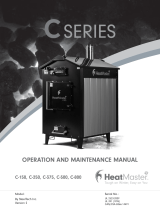 Heatmaster 2019 C Series Owner's manual
Heatmaster 2019 C Series Owner's manual
-
 Heatmaster B250 Biomass Owner's manual
Heatmaster B250 Biomass Owner's manual
-
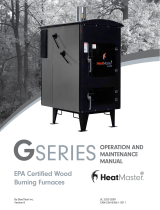 Heatmaster 2020 G Series Owner's manual
Heatmaster 2020 G Series Owner's manual
-
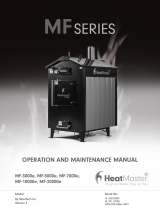 Heatmaster 2018 MF Series Owner's manual
Heatmaster 2018 MF Series Owner's manual
-
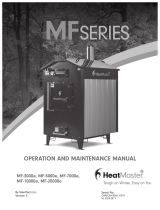 Heatmaster 2021 MF Series Owner's manual
Heatmaster 2021 MF Series Owner's manual
-
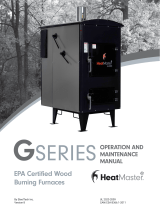 Heatmaster 2021 G Series Owner's manual
Heatmaster 2021 G Series Owner's manual
-
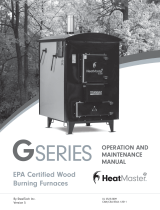 Heatmaster 2019 G GS Series Owner's manual
Heatmaster 2019 G GS Series Owner's manual
-
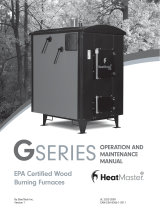 Heatmaster 2020 G Series Owner's manual
Heatmaster 2020 G Series Owner's manual
Other documents
-
Burnham 4NP BioMass-Wood Ratings
-
Pass and Seymour 880 Operating instructions
-
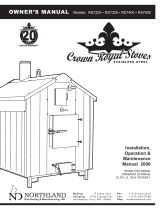 Crown Royal Stoves RS7200 Installation, Operation & Maintenance Manual
Crown Royal Stoves RS7200 Installation, Operation & Maintenance Manual
-
Broan MGC2T(A,K) User manual
-
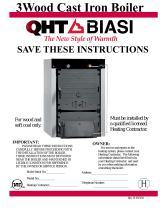 QHT Boiler User manual
QHT Boiler User manual
-
 Heatmor X Series Outdoor Furnaces User manual
Heatmor X Series Outdoor Furnaces User manual
-
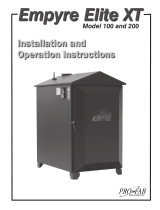 Empyre Empyre Elite XT Specification
Empyre Empyre Elite XT Specification
-
Viessmann PYROMAT ECO 35 Specification
-
Legrand Walkerduct Junction Box Installation guide
-
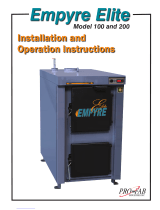 Pro-Fab Industries Empyre Elite 100 Installation And Operation Instructions Manual
Pro-Fab Industries Empyre Elite 100 Installation And Operation Instructions Manual














































